
Impressionism - the beginning of modern art
A short history of French Art - 6.
About-France.com
- the connoisseur's guide to France
Art in France 1850 - 1920 - the reinterpretation of light
The origins of Impressionism
Throughout the history of art, styles and techniques have evolved and changed, and each new departure has sprung from, or been a reaction against, the styles and techniques that came before.Monet has been often described as the father of modern art : but if Monet was the father, others before him had shown the way.
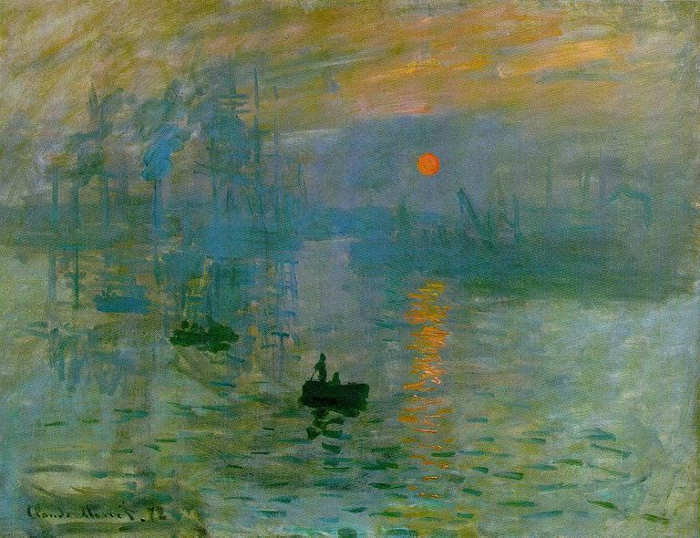
Monet: Impression - soleil levant. Paris Musée Marmotttan
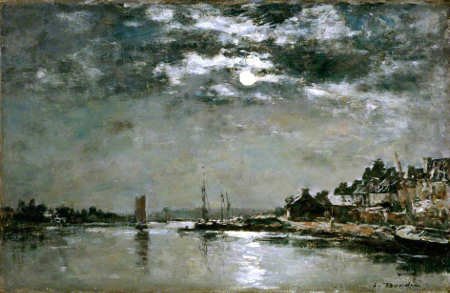
Eugène Boudin -
the village of Le Faou by moonlight.
(Before 1865.)
(Before 1865.)
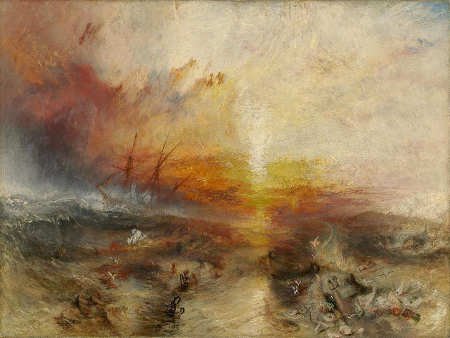
Turner - the Slave Ship (1840) Museum of fine arts, Boston
Generations of painters had filled the backgrounds of their formal works with impressions, for example impressions of light or of landscape as with Claude Lorrain, impressions of darkness with Rembrandt. Among the pioneering landscape artists in France in the mid 19th centuries (see Naturalism), artists like Corot and Daubigny began rendering the play of light in skies or on water, through impressionistic brushstrokes, much in the way that later became the hallmark of Impressionism ; even more impressionistic were many of the works of the seascape artist Eugène Boudin, who retroactively has come to be known as a "Pre-impressionist".
The early Naturalist painters made no secret of their indebtedness to the masters of English landscape art from the early years of the 19th century, in particular Constable and Turner
Indeed, the term "Impressionist" has been used by more than one art historian to describe the technque of Turner. Like the French Impressionists, Turner became fascinated with the effects of light, and many of his most famous paintings, such as Snowstorm at sea or The Fighting Temeraire, are essentially impressionistic, depictions of the play of light through air and water. Monet, who visited London more than once, and painted many pictures of Thames, was familiar with the work of Turner; and even if he did not imitate Turner (in the way that Turner had reinterpreted works by Claude Lorrain), Impressionism sprang out of a metamorphosis in the language of painting that clearly traced its roots back to English landscape art. The emergence of "modern" art was a long process, moved along by many radical and innovating painters. Monet and the Impressionists were an important part of this process.
Impressionism - the beginning of modern art
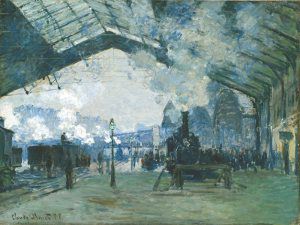 More radically than any artists before them in
France, Monet and the Impressionists took painting in a new direction,
and they did so at a time when society was changing fast..
More radically than any artists before them in
France, Monet and the Impressionists took painting in a new direction,
and they did so at a time when society was changing fast.. Resolutely modern, they seized the opportunity to paint not just landscapes and people, but all aspects of the changing society in which they lived.
Monet was one of the first artists to find inspiration in street scenes and railway stations.
Impressionists strove to escape from the longstanding tradition of painting as a subjective rendering of objective and unmoving reality, towards capturing the ephemeral moment in time, its light and its movement. Turner had done the same half a century earlier, but he had done it in a different way ; the Impressionists painted not just light, but the way it played on surfaces, on water, on snow, through haze and clouds and steam, on leaves and on walls; they painted landscapes, cityscapes, buildings, nature, portraits and a lot more too, but they did not all do so in the same way, and not all the works of the painters generally considered today to have been Impressionists, fit the definition of Impressionism.
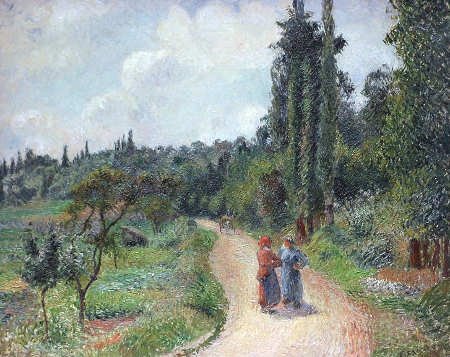
Pissarro
- the Road to Osny - 1883
Impressionism - a movement, not a school
Impressionism was not a school, not even a cohesive group of artists all working together: it was a label attached to a fraternity of a dozen or so radical artists most of whom exhibited their paintings together in Paris between 1874 and 1886. Most were French, but not all.The term Impressionists is frequently misused to include other late 19th century and early 20th century artists who went on to innovate in other ways, and are more correctly referred to as Post-Impressionists.
The work of Monet, which gave Impressionism its name, has come to epitomise the Impressionist style, as it is generally perceived today. Working in a very similar vein were three other artists, Camille Pissarro, Alfred Sisley, and Berthe Morisot. Rather different was Edouard Manet, more of a realist, who even objected for a long time to being bracketed together in artistic terms with Monet
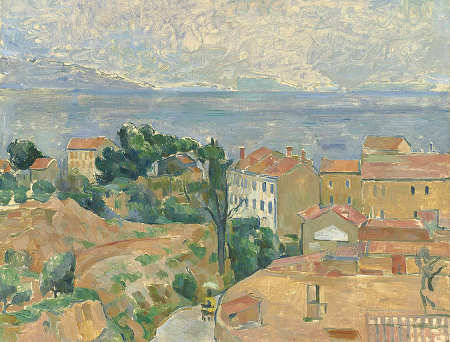
Paul Cézanne - View of l'Estacq - 1882-83 . Private collection
The three other major members of the Impressionist fraternity, Paul Cézanne, Auguste Renoir and Edgar Degas, painted in styles that were quite distinctive and also rather different from the "classic" Impressionist style of Monet. Two other artists frequently referred to as Impressionists, Paul Gauguin and Vincent Van Gogh (see Post-Impressionism), were not part of the movement, though strongly influenced by it, particularly Gauguin who for a while worked with Pissarro and occasionally with Cézanne.
The Impressionists were not a united fraternity, and they were not initially hailed as great painters – rather the reverse. For much of their lives, apart from Degas and Manet who came from wealthy families, most Impressionist painters lived in relative poverty and had difficulty selling their painting.
Yet in an age when "avant-garde" was a term of disapproval, the Impressionists were championed by a few forward-looking dealers, and in particular by the art dealer Durand-Ruel who eventually found a market for Impressionist art outside France, notably in London and New York. In due course the French art establishment took note, and thus by the end of the nineteenth century these previously derided artists were starting to gain recognition even in official circles. In his later years, Monet was actually hailed as one of France's great artists, and some of the waterlily paintings were painted on commission for the French government.
Though the Impressionist movement numbered hardly more than a dozen artists, it unlocked the genie of innovation that was to radically transform French and world art in the decades to come. It was but a short step from Impressionism to the multiple facets of Post-Impressionism, and from then on to Fauvism, Expressionism, Cubism and beyond.
Changing light, changing reality
Among the realities that Monet illustrated in his work was the way light conditions affect the way we see objects. To sophisticated modern audiences surrounded by images, this may seem rather obvious; but to many 19th century viewers, Monet's paintings of Rouen cathedral, so different under different lighting conditions, were an eye-opener.The About-France.com guide to art in France :
- Art and architecture in Medieval France
- French art in the Renaissance
- From Baroque to Rococo - the Grand Siècle and the Age of Enlightenment
- French art in the age of Revolution Neoclassicism to Romanticism
- Naturalism and realism
- Impressionism
- Post-
Impressionism - from
Pointillism to Cubism
Where to see works by the Impressionists in France
Many French art galleries have a handful of works by the Impressionists in their collections; among those with larger collections are:- Paris - Louvre, Orsay, Jeu de Paume, Marmottan : see Impressionists in Paris
- Rouen: Musée des Beaux Arts - the largest colleciton of Impressionist works outside Paris
- Le Havre : Musée André Malraux
- Lyon : Musée des Beaux Arts
- Dijon: Musée des Beaux Arts
Website
copyright © About-France.com 2003 - 2025
Photos: all photos on this page are in the public domain.
Photos: all photos on this page are in the public domain.
About-France.com
Home
page - Site
search
- Regions
- Maps of France
- Contact
Photo top of page : Claude Monet - Trouville,
1870.
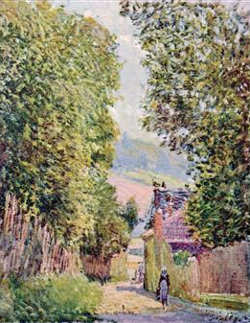
Alfred Sisley - road at Louveciennes

Auguste Renoir - the Swing
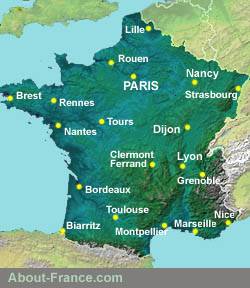
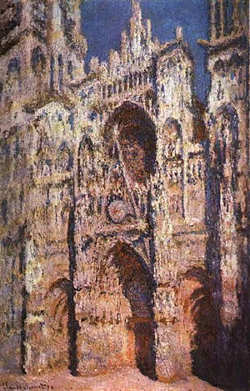
Monet - Rouen cathedral, full sunshine
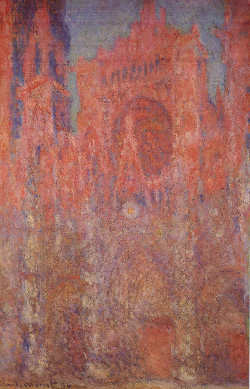
Monet: Rouen cathedral at sunset<
Photos: all photos on this page are in the public domain.
About-France.com is a fully independent website affiliated to certain online booking platforms, and may receive a small commission only on bookings made through affiliate sites . This has no effect at all on the price paid by the visitor.
Copyright texts © About-France.com
Impressionism- 1850 - 1920
The artistic movement that has come to epitomise French painting was very short-lived. It was the movement of a single generation, and of only a dozen or so painters within that generation. Yet the anti-establishment revolution set in motion by the Impressionists released the genie of innovation that was to fundamentally change the rules of pictorial art from that time on.
The artistic movement that has come to epitomise French painting was very short-lived. It was the movement of a single generation, and of only a dozen or so painters within that generation. Yet the anti-establishment revolution set in motion by the Impressionists released the genie of innovation that was to fundamentally change the rules of pictorial art from that time on.

Alfred Sisley - road at Louveciennes

Auguste Renoir - the Swing

| ►► Site guide |
| About-France.com home |
| Full site index |
| About-France.com site search |
| ►► Principal chapters on About-France.com : |
| Guide
to the
regions of France Beyond
Paris, a guide to the French regions and their tourist attractions.
|
| Guide
to Paris Make
the most of your trip to Paris; Information on attractions, Paris
hotels, transport, and lots more.
|
| Accommodation
in France
The different options, including hotels,
holiday gites, b&b, hostels and more
|
| Tourism
in France
The
main tourist attractions and places to visit in France - historic
monuments, art galleries, seasides, and more
|
| Planning
a trip to France
Information
on things to do before starting your trip to France.
|
| Driving
in France
Tips
and useful information on driving in and through France - motorways,
tolls, where to stay....
|
| Maps
of France
Cities,
towns, departments, regions, climate, wine areas and other themes.
|
| The
French way of
life
A mine of information about
life and living in France, including
working in France, living in France, food and eating, education,
shopping.
|
| A-Z
dictionary of France Encyclopedic
dictionary of modern France - key figures, institutions, acronyms,
culture, icons, etc.
|
| ►► More accommodation |
| Gites in France |
| Bed & breakfast in France |
| Small rural campsites |
| Small hotels in France |

Monet - Rouen cathedral, full sunshine

Monet: Rouen cathedral at sunset<
Photos: all photos on this page are in the public domain.
About-France.com is a fully independent website affiliated to certain online booking platforms, and may receive a small commission only on bookings made through affiliate sites . This has no effect at all on the price paid by the visitor.
Click here for
low-cost car hire in France
low-cost car hire in France
Copyright texts © About-France.com
